The culture of serpent worship is deeply rooted in the traditions of India, and it is also the part of religious practices in Hinduism. It has been followed as a tradition since a very ancient time. During the Vedic period , deities like serpents, sun ,moon, wind, ocean etc. were more frequently worshipped than the now-prevalent deities like Brahma ,Vishnu and Shiva.
India also has a huge variety in the species of snakes , that has been worshipped as deities since prehistoric times.In their time of trouble ,people turned to these deities for help . Even Shiva was worshipped as Rudra (ruthless beast form of shiva ) and Pashupati (lord of wild animals) .
Snake worship has been more prevalently mentioned in the Yajurveda and Atharveda.
Importance in Hinduism
Nagas (snakes) have a high status in Hindu scriptures and religious practices.Snakes are considered as a symbol of strength . Since these species can cast off their scales, they are a symbol of rebirth and mortality.
Snakes are also associated with various deities like Shiva wers Vasuki around his neck, and Vishnu rest on the thousand headed Sheshnaag.
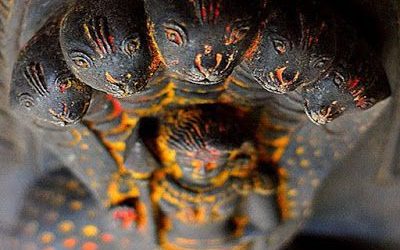
It is believed that killing snakes intentionally in snake groves (in kerala) is a sin which cause a curse on the guilty. When killed unintentionally , they are to be burnt in the same way as humans in Hinduism, and perform Pujas by a priest.
Snake Deities in Hinduism
Atharvaveda mentions the name of serpent Gods, some of them being Asita, Rabhru, Kairata, Prsna, Apodaka, Taimata, etc. Epics like Mahabharata and Ramayana are filled with refrence to the origin of serpent deities and the tradition of their worship.
Brhatsamhita says: "the snakes of the lineage of Taksaka and Vasuki and the snakes roaming at will (kamagah) have bright blue tinged pearls in their hoods”
The epic Mahabharata has a popular story about the origin of the species of serpents . Two sisters named Kadru and Vinita were married to sage Kashyap .Pleased with their devotion Kashyap asked them to ask for a boon. One of them asked for thousand mighty and powerful sons and other asked for two sons more powerful than those thousands of sons.
As a result the thousand sons were born as the serpents of Patal Lok, and the two sons as Garuda and Aruna.
1.Takshaka

Takshaka is the king of serpents called Nagaraja. He is one among those thousands serpents. He is mentioned in Mahabharata. He is mentioned as a friend of Indra .He was a descendent of Ikshavaku dynasty and a descendent of Rama. His son and wife were killed by Arjuna , when he burnt the Khandiva forests to quench the thirst of Agni dev.
To revenge Arjuna and Pandavas ,Takshak killed the last descendent of Kuru dynasty- Maharaja Parikshit , by biting him in the form of a small worm.
He was avenged by Janmajeya , the son of Parikshit and defeated with the entire race of Nagas at Takshshila.
He was to be executed along with entire clan of serpents, but was saved by a learnt boy named Astika, who convinced the king Janmajeya that there would be no victimisation of other clans by the serpent race.
Since then Kurus and Naagas lived in peace.
This day is celebrated as Naag Panchmi in the Hindu traditions.
2.Vasuki
Vasuki is the snake around the neck of Shiva. He offered himself to use him as a rope in the churning of milk ocean during the Samudra Manthan and extract the nectar of immortality. It is believed that Shiva blessed Vasuki and wore him as an ornament. He is considered as the king of nagas and has a gem called Nagamani on his head.
3.Adishesha
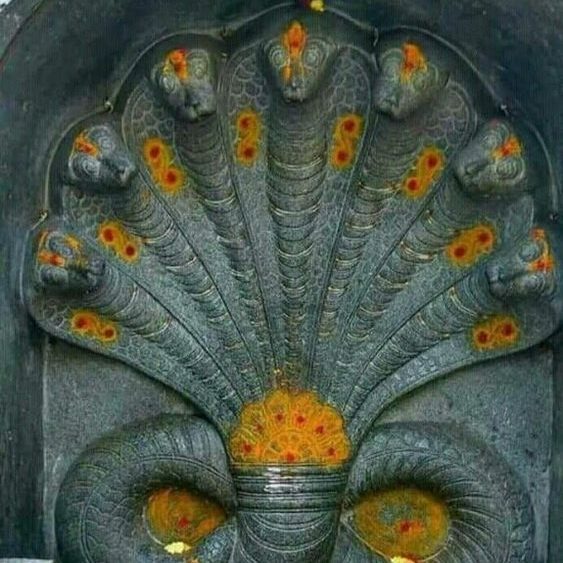
Adhishesha is also called Ananta or Sheshnaag, because he has thousand heads. Along with Vasuki he is called Nagarajas.When the whole world is submerged under the flood ,only thing that remains ,that is Shesha,is Sheshnaag. He accompanies Vishnu in his incarnation . Lakshman in ramayana and Balrama in Mahabharata are his incarnation .He was also a participant in Samudra Manthan.
4.Kaaliya
Kaliya is famous in the folklore of Krishna ,in the incident called Kalinga Nartana. Kaliya was a poisonous snake living in the Yamuna river in Vrindavan. The water boiled and bubbled with poison for four leagues and no human or birds could go near the river. Kaliya was the resident of Ramanaka Dwipa but moved to Vrindavan by the fear of Garuda, the enemy of serpents. Garuda was cursed by a yogi he could not enter Vrindavan. Once when Krishna with his friends were playing on the banks of the river and accidentally the ball fell in the river. Krishna jumped in the river and Kaliya rose up with his hundred and ten hoods vomiting poison.
5.Mansa devi
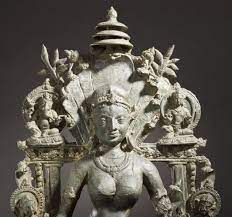
Mansa Devi is the Goddess of serpents worshipped mainly in the states of Odisha,Jharkhand and West Bengal. She cures the snake bites and grants fertility and proserity. She is depicted as Goddess sitting on a lotus or swan,surrounded by snakes.She is the mother of Astika. She is also the sister of Sheshnaag and Vasuki.
There are many temples dedicated to her called Mansa Devi Temple in various parts of Andhra Pradesh and Bengal.
She is also known as Vishhaari – the destroyer of poison.
Other than these , Karkotaka,Shankhapala, Gulika, Padma and Mahapadma are also worshipped in various regions of the country.
Snake Worship in South India
Snake worship in its live form is majorly practiced in south India,especially in Kerala .
It is common to find the serpent groves which are popularly called Sarppakavus, which are maintained and managed by preist and locals. These snakes groves are not supposed to be disturbed . The flora and fauna of these groved has been protected by the locals since ages.
One can find other sacred groves (kavus), which are of religious importance to the people. The deities or animals residing in these groves are believed to be the protector of the community.
In Kerala, serpents are considered as the deities of fertility. They are worshipped by childless couples. Farmers worship them for better crops and harvest.
As a result of these traditions of protecting snakes in south India, the species there have survived till date.

Ashtangis
Just like their is a caste division in the human society in Hinduism, similarily the race of serpents is also divided as follows:
| Deities | Caste |
|---|---|
| Ananta Vasuki Shanghapala Gulika Takshaka Mahapathma Karakotaka Pathma | Brahmin Brahmin Kshatriya Kshatriya Vasihya Vaishya Shudra Shudra |
Nagas and their Iconography
The deities worshipped by the people in the form of snake are called Nagas. As mentioned in the religious scriptures the name does not refer to the ordinary snakes ,but instead to a special race of creatures that are human till naval and the lower body of a serpentine. There are hoods encircling their neck, which vary in number according to their species and gender.
Some of the earliest representations of Nagas in the historic period are of Elapatra and Chakravaka on Bharhut railings (2nd c. BCE). Both are full humans with five hooded snake heads on top and in namaskara mudra showing respect to Buddha.
Naga images found in Mathura , link them to a strong cult .These images are dated back to the Kushan period( 1st century). Some evidence finds mentions of ‘sea of liquor’, ‘palm tree,’ and various other things that show a definite connection with Balrama.
The image of Nagas as deity have changed after the disintegration of Kushan empire and start of Gupta dynasty. Since then, these deities are assisted to major deities like vishnu and Shiva as Vasuki and Ananta.
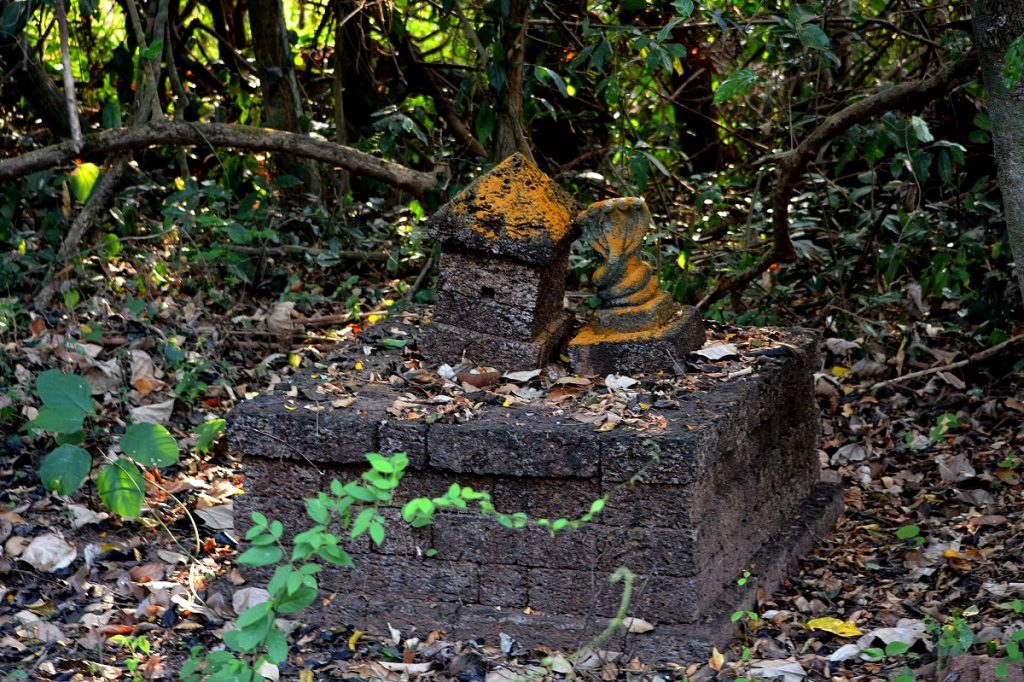
Benefits of this traditon
The tradition of worshipping snakes and considering them as deity has saved a huge species of flora and fauna from getting extinct or atleast vulnerable. People consider them to be their protector from danger and evil , and in turn protect their residence as sacred groves . Not just the snakes, but also the trees are protected in this process.
Underlying cultural and religious beliefs in serpent deities has played a role in protecting iconic animals such as snakes and other species dwelling inside the Western Ghats’ sacred groves. But these values are gradually getting intermixed with the contemporary religious beliefs, which leads to the construction of temples and concrete monuments inside these groves. This is mostly done by people who have lack of knowledge and culture .
When the temples are constructed , the snakes starts moving from their residence to human colonies posing danger to the humans as well as to themselves.
For ages , the local communities have maintained these groves where they managed natural resources and many of these are tied to their cultural and religious beliefs. such groves are relatively undisturbed patches of evergreen forests that sometimes have a pond, stream, or well that ensures perennial water supply. Often located outside of protected areas, sacred groves are rich in biodiversity, housing many threatened and endemic species of plants and animals. It is interesting that when visitors are inside these groves they are very less likely to harm these snakes than when they are outside .This is due to the belief in the protection offered by the snake deities inside the groves. This is a fact ,stated by a survey in the groves of Kerala.
In an attempt to change the tradition of these sacred groves from a residence of wild , feared and sacred animals to an assistance or to link them to the Gods and Goddesses of Hinduism, these groves are getting converted to temples and concrete structures. The entire objective of sacred groves to conserve the biodiversity is vanished because of this.
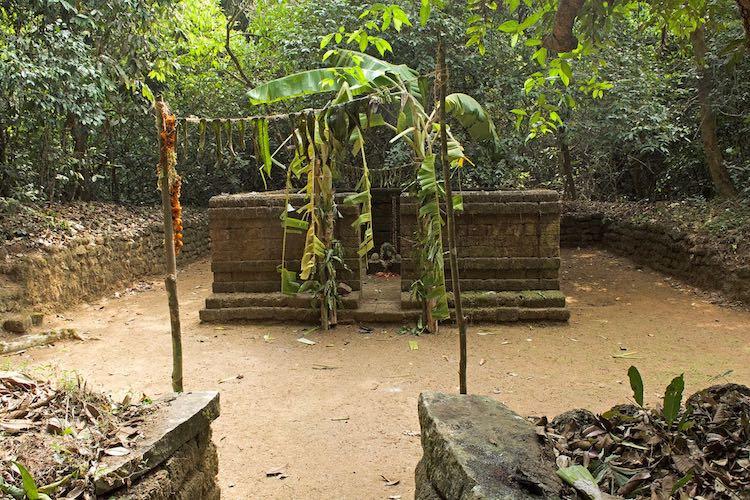
This tradition of snake worshipping is just an another example of the depth of the connections of the Vedic and pre vedic rituals and religious practices to all forms of life . Conservation of flora and fauna is an objective that is deeply rooted in the Indian Vedic philosophy and traditions.